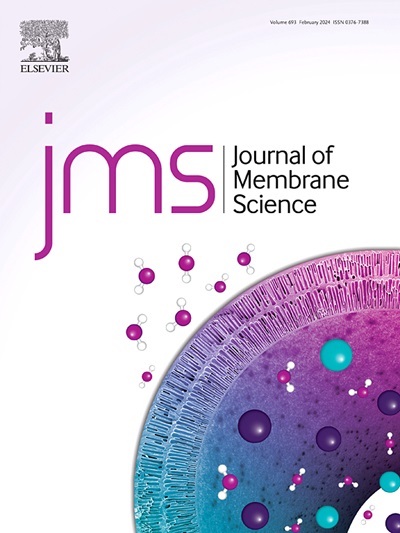ZIF-L填料的孔隙工程以提高pebax基混合基质膜的碳捕获性能
IF 8.4
1区 工程技术
Q1 ENGINEERING, CHEMICAL
引用次数: 0
摘要
金属-有机骨架(mof)填料的孔工程对提高混合基质膜(MMMs)的气体分离性能具有重要的潜力。在这项工作中,我们将拓扑相变策略应用于mmmm填料的孔隙工程。通过超声波在甲醇中加热ZIF-L,在2 h内就实现了相变(比以往的工作快得多,产物记为ZL-2),基本保持了ZIF-L的形貌,但其多孔结构得到了彻底的调节。这使我们能够研究填料孔隙率对mm的微观结构和分离性能的纯粹影响。正电子湮没寿命谱分析表明,纯Pebax膜为单模多孔结构,而ZL-2@Pebax膜(ZL-2填料为10 wt%)为双峰多孔结构,孔隙率较高。这使得与纯Pebax膜相比,CO2/N2分离的渗透率(CO2增加45%)和选择性(增加11%)都有显著提高。这些发现表明MOF填料的孔隙工程对MMMs气体分离性能至关重要。本文章由计算机程序翻译,如有差异,请以英文原文为准。

Pore engineering of ZIF-L fillers to boost the carbon capture performance of Pebax-based mixed matrix membranes
The pore engineering of metal–organic frameworks (MOFs) fillers holds significant potential to enhance the gas separation performance of mixed matrix membranes (MMMs). In this work, we applied the topological phase transformation strategy to the pore engineering of fillers for MMMs. By ultrasonic heating ZIF-L in methanol, the phase transformation was realized in 2 h (much faster than previous works, the product denoted as ZL-2), the morphology of ZIF-L is basically preserved, but its porous structure is thoroughly regulated. This enables us to investigate the pure effect of filler porosity on the microstructure and separation performance of MMMs. As revealed by positron annihilation lifetime spectroscopy, pure Pebax membrane exhibits a unimodel porous structure, but ZL-2@Pebax membrane (ZL-2 fillers of 10 wt%) possesses a bimodal porous structure with a higher porosity. This leads to a remarkable improvement of CO2/N2 separation on both the permeability (45% increment for CO2) and selectivity (11% increment) compared to pure Pebax membrane. These findings address the critical importance of pore engineering of MOF fillers for the gas separation performance of MMMs.
求助全文
通过发布文献求助,成功后即可免费获取论文全文。
去求助
来源期刊

Journal of Membrane Science
工程技术-高分子科学
CiteScore
17.10
自引率
17.90%
发文量
1031
审稿时长
2.5 months
期刊介绍:
The Journal of Membrane Science is a publication that focuses on membrane systems and is aimed at academic and industrial chemists, chemical engineers, materials scientists, and membranologists. It publishes original research and reviews on various aspects of membrane transport, membrane formation/structure, fouling, module/process design, and processes/applications. The journal primarily focuses on the structure, function, and performance of non-biological membranes but also includes papers that relate to biological membranes. The Journal of Membrane Science publishes Full Text Papers, State-of-the-Art Reviews, Letters to the Editor, and Perspectives.
 求助内容:
求助内容: 应助结果提醒方式:
应助结果提醒方式:


